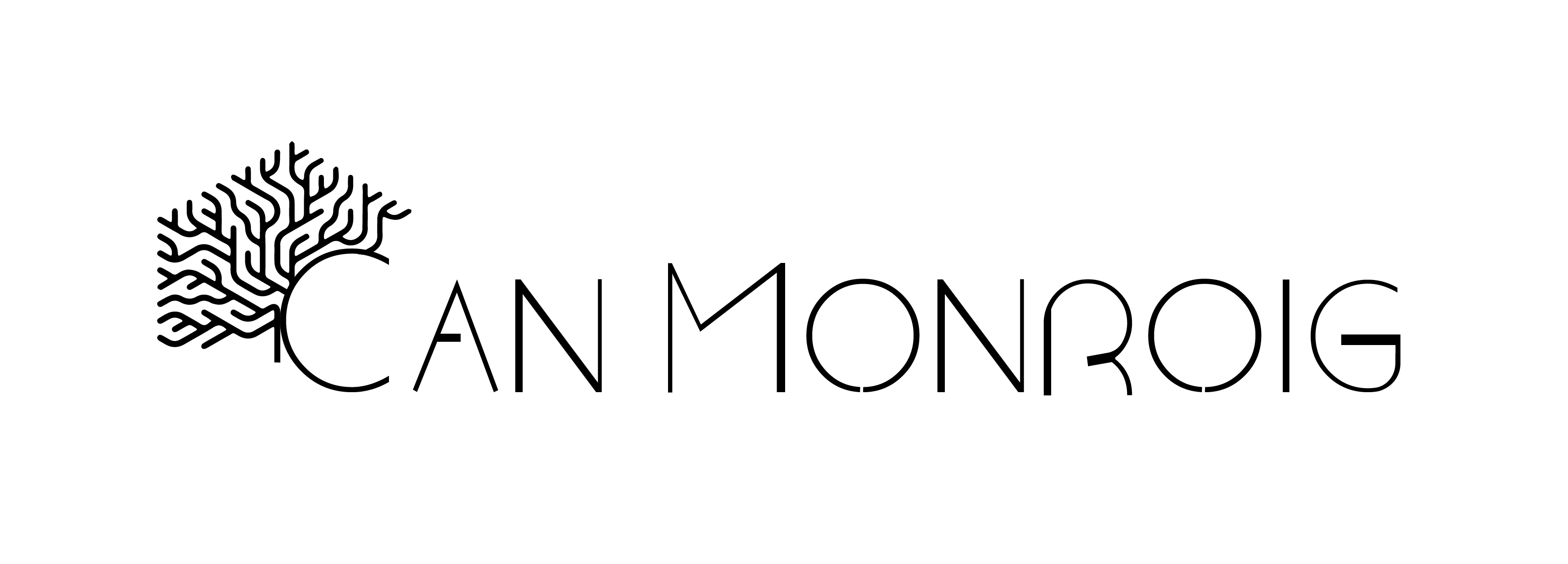
The Can Monroig house is located at number 22 Can Valella street in Inca on the island of Mallorca, where the “Call” or Jewish quarter was located in medieval times.
This house was acquired in 2002 by its current owners Marie-Noëlle Ginard Féron and Robert López Hinton who, between 2004 and 2009, carried out a major restoration of the house during which numerous architectural elements were brought to light that revealed its medieval past.
;
 Facade of Can Monroig before restoration
Facade of Can Monroig before restoration
It was not until 2012, when its owners began to relate some remains found during the renovation of the house, such as the stone deposits or the oven, with other similar remains found in peninsular synagogues, when they became interested in the Jewish past of the neighborhood and studied the characteristics of the synagogues and community spaces shared by medieval Jews.

Needless to say, the house as it is preserved today is already a peculiar and interesting building, but the fact that it is located in the heart of the Jewish quarter of Inca and that it is a house of medieval origin suggests that we may be looking at the headquarters of one or more Jewish institutions.

The “call” of Inca
The creation of the Jewish quarter of Inca in the 14th century was a direct consequence of the increase in violence and the numerous disputes that threatened the peaceful coexistence between the Jewish and Christian communities. This situation became decidedly unsustainable from 1346 onwards, when there were habitual acts of violence and religious coercion by the Christians towards the Jewish community of Inca. These events caused King Pedro IV of Aragon to order the creation of a neighbourhood in which the Jews would live in seclusion to protect themselves from threats from the Christians.

So far, we only have documented the creation of the “Call” in 1372, its perimeter, the two entrance doors, the existence of the synagogue, the cemetery and the butcher shop. The study of the architecture of Can Monroig, the comparison with other buildings, both from the Crown of Aragon and the Crown of Castile, as well as the study of the urban landscape, allow us to formulate the hypothesis that the medieval synagogue of Inca was located in Can Monroig.
Oven found during restoration
It is interesting to note that the synagogue was not only a place of worship, but also a meeting place, something like a civic center that included the entrance through a courtyard, the prayer room, the women's area, the Mikveh, the Talmudic school, warehouses for wine and oil, an oven, etc.
Architectural coincidences of Can Monroig with the elements of a medieval synagogue
“The rabbinical prescriptions collected in the Talmud and the Mishnah regulate the layout of its interior space, which in the Middle Ages revolved around five fundamental axes: the ark or cabinet of the Torah, the tribune, the prayer area, the place reserved for women and children and the azara or entrance courtyard (…) After crossing the threshold of the outer door or doors, one entered directly into the azara or courtyard of the synagogue, an atrium with a basin of water for men to wash their hands (purification ablutions) before entering the prayer room. Women entered the matroneum through a different door than those of the men. In the synagogues there was a space separate from the men, called the matroneum, where women and minor children followed the prayer and worship of the elders.” *(1)

Space and its location
“In general, two of its walls face the street and a third coincides with an alley that leads to the inner courtyard, which, as a side atrium, is essential: shoes are deposited there on fasting days, it is covered with arbors for the Cabañuelas (Sukkot) festival and serves as access to other Jewish community facilities, although to access the women's room different routes are required so that they do not coincide with the men in the courtyard. The presence and number of services attached to the community will vary according to the place and the legal definition, since the generic name as a synagogue is a historiographic simplification in view of the diversity inherent in rabbinical jurisprudence. Inside, the room contains two other doors, including the one that gives access to women.” *(4)

“With the exception of a few specific cases, the dimensions of the buildings are very similar and small. All the known late medieval Catalan synagogues, like practically all those in the whole of the Peninsula, are small, sometimes reaching a minimum of 6.78 m. x 6.84 m., although in general they are between 7 and 9 metres wide and 10 to 15 metres long. These dimensions correspond to the temples of smaller communities as well as those of large Jewish centres, covering the entire group of synagogues currently known in the former Crown of Aragon: Valencia, Palma de Mallorca, Játiva, Tarazona, Calatayud, Seo de Urgel, Cervera, Besalú, Villafranca del Panades, Vic, etc. In short, these are spaces suitable for around fifty seated people, which is usually enough to accommodate the male population attending religious services.” Description of a medieval synagogue *(4)
The Can Monroig house has a floor plan divided into three parallel naves separated from each other by arches from different periods where the entrance to the synagogue, the prayer area, the Hejal and the women's area would hypothetically be located.
 Possible distribution according to Margalida Bernat i Roca (3)
Possible distribution according to Margalida Bernat i Roca (3)
The presence of water
“It is common for the synagogue to be located near a water supply point or a river, which can facilitate not only the cleaning of the sacred space but also that of the faithful, since certain religious practices such as ritual bathing by immersion are often linked to the synagogue. This is the reason why ritual baths or miqvaot often appear in the vicinity of the building or as another dependency of the complex.” *(2)

Well in the yard
As is well known, the presence of water in the area is essential when locating a synagogue since it was essential to have a natural stream of water to supply the Mikveh or ritual bath.
Inca is a city rich in aquifers, abundant underground water and has several streams that surround the historic centre. It is enough to remember the name of the street of water located a few metres from Can Monroig. In turn, the house has three old filtration wells or water table found during the renovation.
The entrance to the synagogue
“In all cases, the entrance to the synagogue never takes place from the public road but through a discreet door leading to the courtyard.” *(4)

 Area of the courtyard that was covered by a ribbed vault
Area of the courtyard that was covered by a ribbed vault
In medieval times, the entrance to the synagogue courtyard was through an alley or androna. This entrance is probably the wall currently walled up on Calle de la Rosa that connects with the Can Monroig courtyard.
From the courtyard one accessed the hall, passing through the well where men could perform their purification ablutions and then to the prayer room.

Possible prayer room
The prayer room where men performed their prayers could have been located in the central nave of Can Monroig, facing the Hejal and looking towards the east.
The matroneo
The matroneum was the name given to the gallery from which women followed the religious services of the synagogue from another room separate from the men. The gallery was usually located on the first floor on the west wall open to the prayer hall.
Windows and niches with views over the possible prayer area
During the restoration, a walled-up niche and window were found on the first floor overlooking the hypothetical prayer room, which are now walled up.
The hejal
The Jewish temple revolves around the correct orientation towards Jerusalem, that is, towards the east of the Iberian Peninsula: one of its walls must be exactly oriented towards the east. The Hejal, a cupboard or niche where the Torah scrolls are stored, is located there.


Niche carved into the wall with stone walls and vault
The hejal (Aron Ha-Kodesh) or cupboard where the Torah or sacred book was kept, could be dug into the wall and above ground level. It was always located on the east wall, as is the case of the two niches found in the wall of Can Monroig in front of the prayer room that bear a great similarity to others found in Portugal either France.

Hejal today, upper and lower niche. The door closes a space that inside is similar to the one below.
Mikveh or ritual bath 
The mikveh is the space where the purification baths prescribed by Judaism are performed. It is a container of water where a person can completely immerse himself,
The chamber had a container of variable size but not too large, which was accessed via stairs. The water it contained had to come from a natural source or be filtered, non-stagnant running water. This space was used by men and women.


Aim
Our aim is to create a multidisciplinary team made up of historians, architects, artists and archaeologists to study Can Monroig and the Jewish quarter of Inca. We have the support of historians specialising in Judaism in the Balearic Islands, Guillem Reus Planels and Margalida Bernat Roca, as well as people related to the Jewish world, such as Dani Rotstein, an American Jew living in Mallorca, who is very involved in the dissemination of the Jewish history of Mallorca, “Xueta”, or the Argentine-Jewish architect and visual artist Claudio Capellini.
Together we want to develop the hypothesis of Can Monroig as an ancient Inca Synagogue (1346-1391), investigating the related historical archives, through archaeological excavations in areas of the house that have not yet been studied, such as the oven wells, the hejal niches or the window and the niche located in the matroneo area.
The aim is to promote the cultural heritage of Inca and Mallorca through the creation of a research centre located in Can Monroig.
Marie-Noëlle Ginard Feron and Robert López Hinton are dedicated to the restoration of old houses in Mallorca, they live and work in Can Monroig where they also maintain an intense cultural and artistic activity.

Text based on the publications of Guillem Reus i Planells, PhD in art history from the Autonomous University of Barcelona
“Notes on the history of the Inca jueus and his Call” XVIII Jornades d'Estudis Locals, Inca, 2014.
“El barri jueu d'Inca (Mallorca). Urbanisme and architecture of the call (1346-1391)” / Els jueus a les Balears. XXXVI Jornades d'Estudis Històrics Locals. Institut d'Estudis Baleàrics, Palma, 2020.
“Calli Judeorum Incha. A hypothesis for the location of the medieval Inquean synagogue” XXI Jornades d'Estudis Locals. Inca (in press).
Literature:
*(1) “Archaeological indicators for the identification of medieval Hispanic Jewish populations” Jorge A. Eiroa, University of Murcia
“The synagogue of Híjar, successes and errors” by Álvaro Lope Asensio.
* (2) “Lorca, lights of Sefarad”
*(3) “Cementeris and synagogues of the city of Mallorca” Margalida Bernat i Roca
“The Jews of Inca” Sfarad.es, the portal of Judaism in Spain
“Economic and political activities of the Jews of the Balearic Islands in the Late Middle Ages (1229-1391) Volume I Thesis by Jordi Maíz Chacón.
* (4) “On the identification of medieval synagogues: The case of Tárrega”
Hypothesis-synagogue-Spanish-English
Notes on the history of the Jews of Inca
Calli judeorum Incha. A hypothesis for the location of the medieval Inquean synagogue

